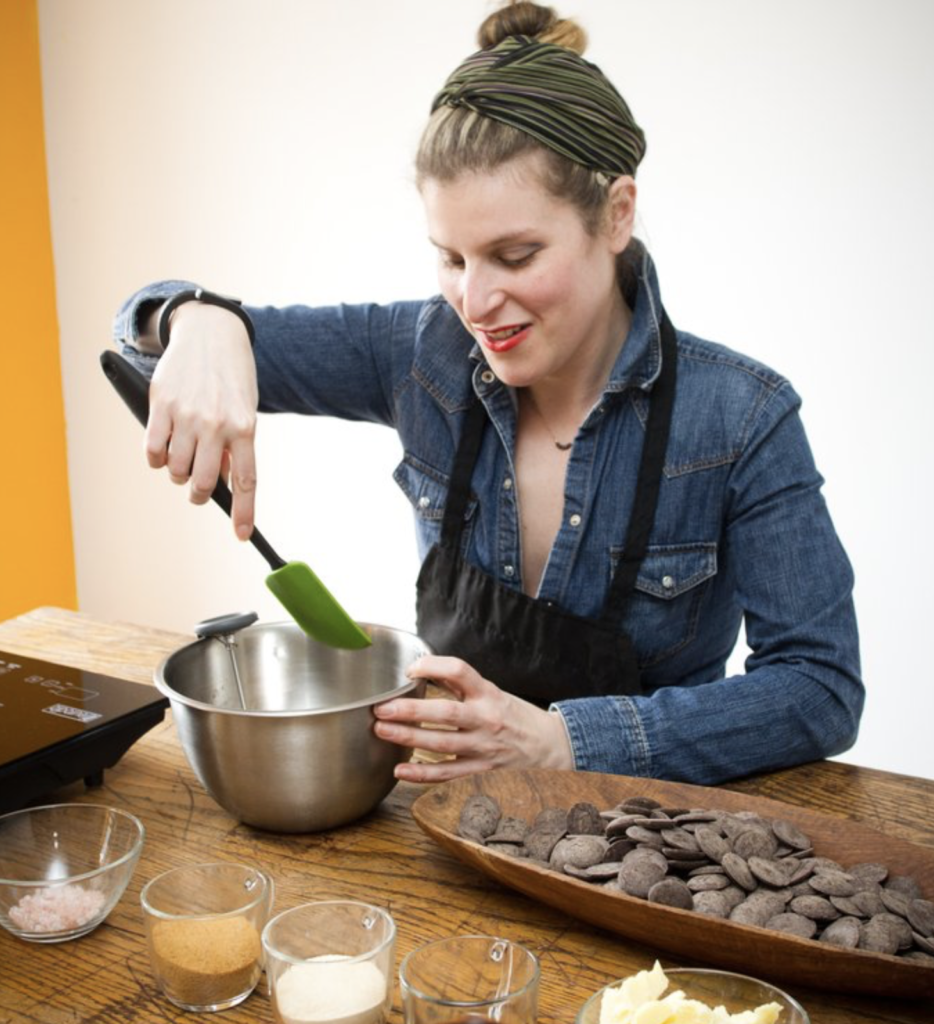From her basement kitchen in her mother-in-law’s Fort Greene row house, Beryl Fine is making a name for herself in Brooklyn’s chocolate industry with her sultry sweets brand, Haute Chocolate. The California native and art- school dropout has found a niche within the borough’s celebrated artisanal-chocolate scene by using a branding tactic her largely male competitors have not capitalized on: specifically targeting female consumers.
“I’m trying to position my product as a luxury gift item,” says Fine as she zooms around her workspace (a rare basement space with a 20-C food-service license in Brooklyn, she was told by regulators), “I want it to be sacred.” With an aesthetic she describes as “a cross between riot grrrl zines and French noir-film poster art,” Fine goes about imbuing this sense of sacredness by wrapping her product in gold foil and a range of hedonistic photographs of women–all of which she takes herself.
The Salted Rosemary bar ($8) is a top-seller with a suitably sultry product description: “Delicate skin. A predator smile. She can give or take life with just one breath; such is her control”
Photography is what originally brought Fine to New York City, but after failing to break into the prohibitive field, she decided to embrace her entrepreneurial instincts and turn the medicinal-marijuana chocolates she’d been making for friends into a legitimate, legal operation. After watching tons of YouTube videos on tempering tactics and taking three classes at Manhattan’s Institute of Culinary Education, she had herself a business.
The first retailer of her chocolate was Shag, a Williamsburg “sexy shop” which holds workshops and sells art and jewelry in addition to adult toys. In order to get on store shelves, Fine bemoans, she had to make the packaging a bit more PG and less DIY than the photocopied images she’d been previously using. The refinements have paid off, she reports. While the packaging is often what gets attention, Fine delivers adventurous flavors within, ranging from salted-rosemary and toasted-almond bars to cinnamon-chipotle hot chocolate.
“It’s been the most successful thing I’ve done in my adult life. I’m very happy with the way things are going,” she says. “I’m always hovering around a seven or an eight out of ten,” which not every entrepreneur can say. The business celebrated its three-year anniversary in May and is on track to grow around 11% in revenues this year, matching 2017’s growth.
The Pandora’s Box sampler offers 18 pieces for $35
To accommodate the scaling-up process, Fine recently expanded her operation by hiring a contract packager (called a co-packer in the industry) on the West Coast to produce some of her product for her, allowing for larger batches of the sweets and freeing up time for Fine to manage the rest of the business. “I make all of the minis, semi-sweet and the hot chocolate by hand here,” she says proudly, but “now I’m not making each fucking chocolate bar by hand, which is delightful.”
“A lot of people, they have these big machines that do it,” she goes on as she points a digital-thermometer gun at the single-flavor batch of chocolates she’s currently whipping up in a bowl. It’s hard to imagine where she’d fit a big machine in the endearing but tight space of her subterranean chocolate laboratory. Her sink, which constituted the most expensive, regulation-heavy part of getting a commercial license, she tells me, is in a separate part of the basement.
Working with a co-packer is, “a process, and it’s also a relationship,” says Fine, the California company she found has been a good fit. She initially contacted co-packers on the East Coast, but they tended to prefer working with higher-volume brands.
Fine, originally a photographer by vocation, brings a certain mystique to her brand
With some of the production out of her hands, Fine can now focus more energy on creating new flavors, like her black-sesame bar. Fine thinks the salted-rosemary bar is Haute Chocolate’s most daring current flavor and the new one, to be introduced next month, will surpass it. “The black sesame is going to be our new token weird flavor.” While some of Haute Chocolate’s bars offer relatively familiar chocolate tastes–coconut, espresso, semi-sweet–others are more surprising: hibiscus, spiced chai, lady grey (a playful take on Earl Grey tea). The mix is intentional, since Fine says her goal is to go for “what’s familiar and also what’s bold.”
It’s the texture, not the flavor, though, which Fine believes keeps customers coming back. “It’s not smooth,” she says, “the sugar isn’t ground down.” Many customers compare it to Mexican chocolate.
Despite the plentiful competition in the borough, with Brooklyn boasting multiple chocolate factories of larger size than Haute Chocolate’s operation, Fine says her colleagues have played nice. “I think that people are very competitive, so it’s hard for some to be friendly,” she admits, but she hasn’t had any negative experiences. One fellow Brooklyn chocolatier even offered free advice in her weed-chocolate days, which served her well in Haute Chocolate’s earliest stages.
As for a brick-and mortar-future, Fine has no plans at the moment, although she does have some ideas. “If I do a storefront, I want there to be a cafe and no WiFi–an escape,” Fine said. What she does have coming up are appearances at the Nuance conference on July 21 and the NY NOW trade show next month. Meanwhile, she’s looking for a distributor to open up foreign markets. Haute Chocolate can also be ordered online, or found at a number of shops in Brooklyn and Manhattan.
